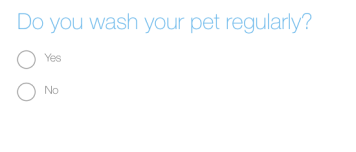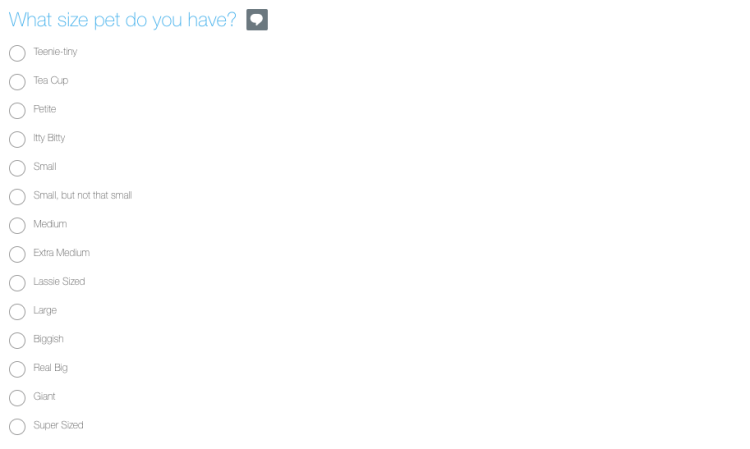Mobile Surveys 101: The Good, The Bad, and The Ugly of Question Writing
Now that you have worked through the planning stage and have a good understanding of question types, it’s time to jump-in and start writing your survey! As you begin crafting your questionnaire you should keep a few things in mind.
This simple guide will help you write good survey questions while avoiding bad mistakes and ugly issues (it’s a theme, get it?). If you follow these hints you will be getting the best data possible–without getting a headache.
Leading Questions and Bias
Avoid leading your respondents towards your preferred answer. Easier said than done, right? It’s hard to not let your experiences influence our question writing– especially when you truly believe in your cause or product. But be careful! Even small wording choices can subtly influence respondents answers.
The Good:

The Bad:

A good way to avoid bias is to have a coworker or friend read your survey and try to guess what answer you want them to pick. If they are able to easily tell what your preference is, re-work your questions until you have cleared out the bias.
Specific Questions
Be clear and direct with your questions, and only ask one thing per question. While most surveys should have a few broad demographic or general information questions like “what is your age?” or “how many children do you have?”, the majority of your survey should be specific questions with concrete answers.
The Good:

The Bad:

Words like “regularly” or “sometimes” are confusing and don’t always mean the same thing to every respondent. Use direct language and you will get clearer and more reliable data. Also, watch out for dichotomous questions— questions that don’t have an independent answer.
PRO TIP: A good rule of thumb is to ask broader questions at the beginning of your survey, and get more specific as you move along. This is known as the funnel method, and it’s a great way to create a seamless flow for your surveys.
Lingo, Jargon, and Confusing Words
While you may be an expert in your field, your respondents probably aren’t. It is important to avoid specialized terms and industry jargon. Regional differences and slang can also cause issues. Remember, what may seem normal to you can look like gibberish to another person– so keep your eyes open for potentially problematic terms.
The Good:
 The Bad:
The Bad:

Of course, some research is going to be catered to a specific audience (such as a survey of medical professionals). A certain amount of lingo is acceptable depending on what respondents you are targeting. To strike a good balance, it’s best to think in averages–what questions would the average member of your target understand? It’s always best to err on the side of caution–respondents can’t answer a questions they don’t understand.
Don’t Force Answers
In research, you sometimes have to ask very personal questions that can make some respondents uncomfortable. While we want to give respondents every opportunity to answer–it’s always a good idea to give them a way out.
The Good:
Simply adding a “prefer not to answer” or “other” field where they can state that they are uncomfortable is an easy way to keep respondents from feeling like they are being forced to answer questions they find inappropriate. You can also make use of a content disclaimer or targeting to ensure that your respondents will be comfortable with the subject matter of your research.
The Bad:
This is a safe-for-work blog, so I’m just going to assume everyone knows what a bad example of an inappropriate question would be. You don’t want your respondents to abandon your survey part way through. Be aware of your audience as you craft questions about sensitive subject, give them the flexibility to move forward in the survey without answering, and (as always) keep it classy.
Choose your Answer Choices Wisely
One of the most difficult parts of survey writing is creating lists of possible answers. You need to provide enough answers that you cover everything. You don’t want your respondents left without an answer that matches their preference–but you don’t want to overwhelm them or create giant and ugly answer-banks.
The Good:
 The Bad:
The Bad:

Choosing answers can be difficult, and can cause you writer’s block. Fight through blocks as you brainstorm by making good use of drafting. On your first draft, don’t worry about having too many choices–just get your ideas out on paper. Then, as you go back through your survey, cut down unnecessary answers and trim the fat until you have a balanced set of choices.
Weigh Your Scales Appropriately
When setting up a scale, it’s important to choose your weights carefully. For Rating scales, this means choosing a realistic number range that applies to your question. For Likert scales, give reasonable answers in an order that makes sense.
The Good:
 The Bad:
The Bad:

In some instances it’s appropriate to use an unbalanced scale–a scale that compensates for the most common or expected answers. For example, if your target is guaranteed to spend at least $20 a month on pet products, there is no use having $1-19 on your scale. But use these scales carefully! Improper use of unbalanced scales can create bias and skew your data.
Also, be sure choose the right scale type to match your question. Refresh your mind here for more on using Likert and Rating scales.
Avoid the Ugly
Looks aren’t everything, but in research they do matter. The way your survey displays can have a huge effect on your respondent’s experience and your data.
Now that your questions and answers are solidly in the good category, take a few minutes to make sure they look good too.
Here is a basic checklist to make sure your survey has that professional shine:
- Proofread for spelling and grammar
- Check mobile formatting, especially for scales and matrix questions
- Test for question length and total survey length.
- Make sure your images display properly
For more information on making your research beautiful, watch out for our next Mobile Surveys 101 post– Let’s Get Visual: Mobile Design Elements.
<Previous Home Next>